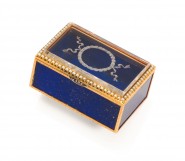Lot #9 - Danila Vassilieff
-
Auction House:Deutscher and Hackett
-
Sale Name:Important Australian + International Art
-
Sale Date:29 Aug 2018 ~ 7pm (AEST)
-
Lot #:9
-
Lot Description:Danila Vassilieff
(1897 – 1958)
Theatre Party, 1944
oil on composition board
57.0 x 68.5 cm
signed lower left: Vassilieff; bears inscription with title verso: “THEATRE PARTY”
EXHIBITED: Possibly: "Sixth Annual Exhibition," Contemporary Art Society, Melbourne, 1944, cat. 237 (as ‘And So it is’) ; "Vassilieff", Heide Park and Art Gallery, Victoria, 11 August – 22 September 1985; Australian National Gallery, Canberra, 12 October 1985 – 2 February 1986; Art Gallery of New South Wales, Sydney, 4 March – 2 April 1986, cat. 33 (illus. in exhibition catalogue) ; "The Angry Penguins and Realist Painting in Melbourne in the 1940s", Australian National Gallery, Canberra, and touring: Hayward Gallery, London, 19 May – 14 August 1988, Tate Gallery, Liverpool, 4 October – 27 November 1988, cat. 4 (illus. in exhibition catalogue, labels attached verso) -
Provenance:John Reed, Melbourne ; Blue Boy Art Gallery, Melbourne; Alan and Nola Geddes, Sydney, acquired from the above c.1977 ; Estate of Nola Geddes, Sydney
-
References:St John Moore, F., "Vassilieff and His Art", Oxford University Press, Oxford / Auckland / New York, 1982, cat. P184, pp. 64, 65 (illus.), 152 St John Moore, F., "Vassilieff and His Art," second edition, Macmillan, Melbourne, 2012, cat. 251, pp. 76, 201
-
Notes:"Theatre Party", 1944, is a passionate painting executed by a passionate man, the Russian-born expatriate Danila Vassilieff. Such was the force of Vassilieff’s personality that his younger colleague Albert Tucker was moved to later write that he ‘was a rich and sombre presence who carried with him the odor of Byzantium and the Circassian Steppes. In his life, he expressed to the full the pathos and loneliness, the violence and tragedy of our human condition’.1 Of Cossack military heritage, Vassilieff had fought in revolutions, swum rivers to escape his pursuers, been jailed, escaped, and then travelled extensively before arriving in Australia (for the second time) in 1935. This time he stayed, first in Sydney, then Queensland before relocating to Melbourne in 1937. En route, he also found time to study art in Rio de Janeiro and hold exhibitions in London. On arrival in Melbourne, he soon made contact with influential art patrons John and Sunday Reed and in the process, electrified the local art scene. Reed subsequently opened Vassilieff’s first local exhibition at Riddell’s Gallery in September 1937 and by 1940, younger artists such as Arthur Boyd, Sidney Nolan, Yosl Bergner and John Perceval were ‘literally sitting at his feet. They were attracted by his virility and earthiness, his civility and the physicality of everything’.2 Of particular fascination to these young artists was Vassilieff’s unequivocal rejection of both academic art and formal abstraction, both of which he rejected as being ‘ghastly good taste’.3 Instead, his reference points were those artists of a pronounced expressive nature, such as Van Gogh and Soutine, as well as the "naïf "Marc Chagall, all" "intermingled with the folkloric influence of his own Russian heritage. In short, it was an outlook unheard of in Australian art circles and proved an intoxicating mix for his young acolytes. Vassilieff was also very active in the newly formed Contemporary Art Society, contributed to the Max Harris/John Reed journal "Angry Penguins", and helped build, then taught at, the progressive communal school ‘Koornong’. Politics too were never far from his thoughts and when Nazi Germany invaded Russia in 1941, he was both outraged and dismayed, pouring his energy into works with titles such as "Army invading Farmland", 1941 – 42; "Camp Followers", 1942;" "and "A Mother Screaming"," "1944. In "Theatre Party", however, another side of Vassilieff is displayed, that of his tempestuous interactions with various female partners. Painted toward the end of one such relationship with Helen MacDonald, the artist has depicted his (suspected) rival sitting in a theatre box, lit from below by the stage lights in a manner reminiscent of Toulouse-Lautrec and Daumier. It is a grotesque apparition but fascinating nonetheless. Vassilieff’s hapless subject is rendered in urgent passages of paint with dandy-esque white gloves, alongside Helen and her ghost-faced companions, all portrayed as if the artist was desperate to get his emotions down in paint before they otherwise consumed him. Following many years of neglect, the art of Danila Vassilieff is now increasingly and positively re-appraised, not least through the energies of his biographer Felicity St John Moore. In 2015, her son Richard Moore directed the film "The Wolf in Australian Art: Life and Art of Danila Vassilieff "based on her books. 1. Tucker, A.," Memorial Exhibition of Paintings and Sculpture of Danila Vassilieff", Museum of Modern Art in Australia, Melbourne, 1959 2. St John Moore, F., "Vassilieff and his Art", Oxford University Press, Melbourne, 1982, p. 59 3. Haese, R., "Rebels and Precursors: The revolutionary years of Australian Art", Penguin, Melbourne, 1981, p. 78 ANDREW GAYNOR
-
Estimate:A$20,000 - 30,000
-
Realised Price:
-
Category:Art
This Sale has been held and this item is no longer available. Details are provided for information purposes only.










